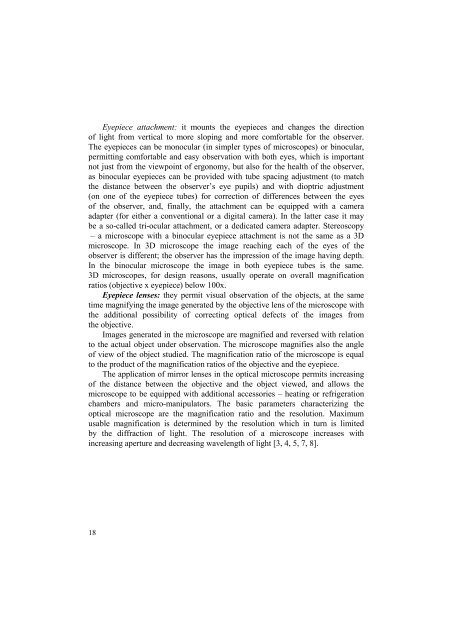MICRO-STRUCTURE ANALYSIS OF PLANT TISSUES - Lublin
MICRO-STRUCTURE ANALYSIS OF PLANT TISSUES - Lublin
MICRO-STRUCTURE ANALYSIS OF PLANT TISSUES - Lublin
Create successful ePaper yourself
Turn your PDF publications into a flip-book with our unique Google optimized e-Paper software.
Eyepiece attachment: it mounts the eyepieces and changes the direction<br />
of light from vertical to more sloping and more comfortable for the observer.<br />
The eyepieces can be monocular (in simpler types of microscopes) or binocular,<br />
permitting comfortable and easy observation with both eyes, which is important<br />
not just from the viewpoint of ergonomy, but also for the health of the observer,<br />
as binocular eyepieces can be provided with tube spacing adjustment (to match<br />
the distance between the observer’s eye pupils) and with dioptric adjustment<br />
(on one of the eyepiece tubes) for correction of differences between the eyes<br />
of the observer, and, finally, the attachment can be equipped with a camera<br />
adapter (for either a conventional or a digital camera). In the latter case it may<br />
be a so-called tri-ocular attachment, or a dedicated camera adapter. Stereoscopy<br />
– a microscope with a binocular eyepiece attachment is not the same as a 3D<br />
microscope. In 3D microscope the image reaching each of the eyes of the<br />
observer is different; the observer has the impression of the image having depth.<br />
In the binocular microscope the image in both eyepiece tubes is the same.<br />
3D microscopes, for design reasons, usually operate on overall magnification<br />
ratios (objective x eyepiece) below 100x.<br />
Eyepiece lenses: they permit visual observation of the objects, at the same<br />
time magnifying the image generated by the objective lens of the microscope with<br />
the additional possibility of correcting optical defects of the images from<br />
the objective.<br />
Images generated in the microscope are magnified and reversed with relation<br />
to the actual object under observation. The microscope magnifies also the angle<br />
of view of the object studied. The magnification ratio of the microscope is equal<br />
to the product of the magnification ratios of the objective and the eyepiece.<br />
The application of mirror lenses in the optical microscope permits increasing<br />
of the distance between the objective and the object viewed, and allows the<br />
microscope to be equipped with additional accessories – heating or refrigeration<br />
chambers and micro-manipulators. The basic parameters characterizing the<br />
optical microscope are the magnification ratio and the resolution. Maximum<br />
usable magnification is determined by the resolution which in turn is limited<br />
by the diffraction of light. The resolution of a microscope increases with<br />
increasing aperture and decreasing wavelength of light [3, 4, 5, 7, 8].<br />
18

















